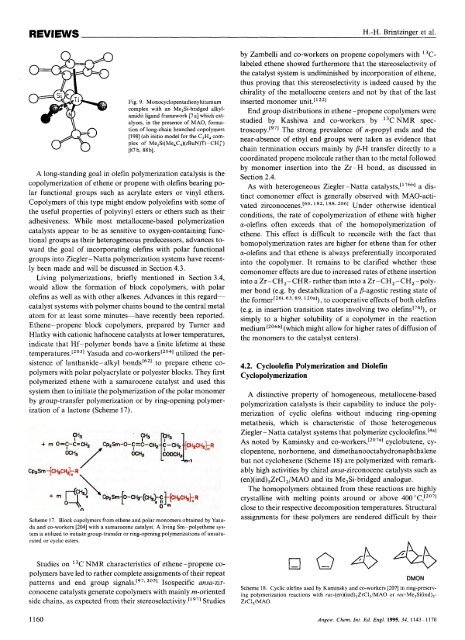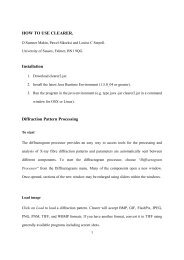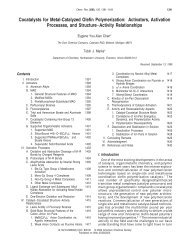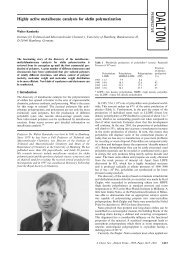Stereospecific Olefin Polymerization with Chiral Metallocene Catalysts
Stereospecific Olefin Polymerization with Chiral Metallocene Catalysts
Stereospecific Olefin Polymerization with Chiral Metallocene Catalysts
Create successful ePaper yourself
Turn your PDF publications into a flip-book with our unique Google optimized e-Paper software.
REVIEWS H.-H. Brintzinger et al.<br />
Fig. 9. Monocyclopentadienyltitanium<br />
complex <strong>with</strong> an Me,Si-bridged alkyl-<br />
amido ligand framework [7a] which cat-<br />
alyzes, in the presence of MAO, forma-<br />
tion of long-chain branched copolymers<br />
[198] (ab initio model for the C,H, com-<br />
plex of Me,Si(Me,C,)(tBuN)Ti-CH:)<br />
[87b, 88b].<br />
A long-standing goal in olefin polymerization catalysis is the<br />
copolymerization of ethene or propene <strong>with</strong> olefins bearing polar<br />
functional groups such as acrylate esters or vinyl ethers.<br />
Copolymers of this type might endow polyolefins <strong>with</strong> some of<br />
the useful properties of polyvinyl esters or ethers such as their<br />
adhesiveness. While most metallocene-based polymerization<br />
catalysts appear to be as sensitive to oxygen-containing functional<br />
groups as their heterogeneous predecessors, advances toward<br />
the goal of incorporating olefins <strong>with</strong> polar functional<br />
groups into Ziegler-Natta polymerization systems have recently<br />
been made and will be discussed in Section 4.3.<br />
Living polymerizations, briefly mentioned in Section 3.4,<br />
would allow the formation of block copolymers, <strong>with</strong> polar<br />
olefins as well as <strong>with</strong> other alkenes. Advances in this regardcatalyst<br />
systems <strong>with</strong> polymer chains bound to the central metal<br />
atom for at least some minutes-have recently been reported.<br />
Ethene-propene block copolymers, prepared by Turner and<br />
Hlatky <strong>with</strong> cationic hafnocene catalysts at lower temperatures,<br />
indicate that Hf-polymer bonds have a finite lifetime at these<br />
temperatures.[2031 Yasuda and c~-workers[~~~~ utilized the persistence<br />
of lanthanide-alkyl bonds[621 to prepare ethene copolymers<br />
<strong>with</strong> polar polyacrylate or polyester blocks. They first<br />
polymerized ethene <strong>with</strong> a samarocene catalyst and used this<br />
system then to initiate the polymerization of the polar monomer<br />
by group-transfer polymerization or by ring-opening polymerization<br />
of a lactone (Scheme 17).<br />
Scheme 17. Block copolymers from ethene and polar monomers obtained by Yasu-<br />
da and co-workers [204] <strong>with</strong> a samarocene catalyst. A living Sm-polyethene sys-<br />
tem is utilized to initiate group-transfer or ring-opening polymerizations of unsatu-<br />
rated or cvclic esters.<br />
Studies on 13C NMR characteristics of ethene-propene copolymers<br />
have led to rather complete assignments of their repeat<br />
patterns and end group signals.[97* '05] Isospecific ansa-zirconocene<br />
catalysts generate copolymers <strong>with</strong> mainly rn-oriented<br />
side chains, as expected from their stereosele~tivity.['~~~ Studies<br />
by Zambelli and co-workers on propene copolymers <strong>with</strong> I3Clabeled<br />
ethene showed furthermore that the stereoselectivity of<br />
the catalyst system is undiminished by incorporation of ethene,<br />
thus proving that this stereoselectivity is indeed caused by the<br />
chirality of the metallocene centers and not by that of the last<br />
inserted monomer unit.[1221<br />
End group distributions in ethene-propene copolymers were<br />
studied by Kashiwa and co-workers by 13CNMR spectros~opy.[~']<br />
The strong prevalence of n-propyl ends and the<br />
near-absence of ethyl end groups were taken as evidence that<br />
chain termination occurs mainly by P-H transfer directly to a<br />
coordinated propene molecule rather than to the metal followed<br />
by monomer insertion into the Zr-H bond, as discussed in<br />
Section 2.4.<br />
As <strong>with</strong> heterogeneous Ziegler-Natta<br />
a distinct<br />
comonomer effect is generally observed <strong>with</strong> MAO-activated<br />
zirconocenes.[66' '*'* '06] Under otherwise identical<br />
conditions, the rate of copolymerization of ethene <strong>with</strong> higher<br />
a-olefins often exceeds that of the homopolymerization of<br />
ethene. This effect is difficult to reconcile <strong>with</strong> the fact that<br />
homopolymerization rates are higher for ethene than for other<br />
a-olefins and that ethene is always preferentially incorporated<br />
into the copolymer. It remains to be clarified whether these<br />
comonomer effects are due to increased rates of ethene insertion<br />
into aZr-CH,-CHR- rather thaninto aZr-CH,-CH,-polymer<br />
bond (e.g. by destabilization of a P-agostic resting state of<br />
the former[Z6i.63, 89.120al ), to cooperative effects of both olefins<br />
(e.g. in insertion transition states involving two olefin~['~]), or<br />
simply to a higher solubility of a copolymer in the reaction<br />
medium[206b1 (which might allow for higher rates of diffusion of<br />
the monomers to the catalyst centers).<br />
4.2. Cycloolefin <strong>Polymerization</strong> and Diolefin<br />
C yclopolymerization<br />
A distinctive property of homogeneous, metallocene-based<br />
polymerization catalysts is their capability to induce the polymerization<br />
of cyclic olefins <strong>with</strong>out inducing ring-opening<br />
metathesis, which is characteristic of those heterogeneous<br />
Ziegler- Natta catalyst systems that polymerize cy~loolefins.[~"~<br />
As noted by Kaminsky and co-w~rkers,[~~~~l cyclobutene, cyclopentene,<br />
norbornene, and dimethanooctahydronaphthalene<br />
but not cyclohexene (Scheme 18) are polymerized <strong>with</strong> remarkably<br />
high activities by chiral ansa-zirconocene catalysts such as<br />
(en)(ind),ZrCl,/MAO and its Me,Si-bridged analogue.<br />
The homopolymers obtained from these reactions are highly<br />
crystalline <strong>with</strong> melting points around or above 400 0C,[2071<br />
close to their respective decomposition temperatures. Structural<br />
assignments for these polymers are rendered difficult by their<br />
DMON<br />
Scheme 18. Cyclic olefins used by Kaminsky and co-workers [207] in ring-preserving<br />
polymerization reactions <strong>with</strong> ruc-(en)(ind),ZrCI,/MAO or ruc-Me,Si(ind),-<br />
ZrCIJMAO.<br />
1160 Angew. Chem. Inr. Ed. Engl. 1995, 34, 1143-1170






